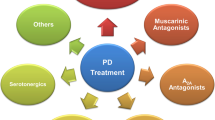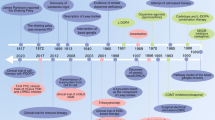Abstract
Advances in understanding the molecular mechanisms of cell death and the pathogenesis of sporadic and familial Parkinson's disease are creating new opportunities for the development of neuroprotective and/or neurorestorative therapies. Here we review many of these advances, highlighting areas and strategies that might be particularly suited to the development of innovative approaches that prevent degeneration and/or restore function in Parkinson's disease.
This is a preview of subscription content, access via your institution
Access options
Subscribe to this journal
Receive 12 print issues and online access
$209.00 per year
only $17.42 per issue
Buy this article
- Purchase on Springer Link
- Instant access to full article PDF
Prices may be subject to local taxes which are calculated during checkout



Similar content being viewed by others
References
Lang, A.E. & Lozano, A.M. Parkinson's disease. First of two parts. N. Engl. J. Med. 339, 1044–1053 (1998).
Lang, A.E. & Lozano, A.M. Parkinson's disease. Second of two parts. N. Engl. J. Med. 339, 1130–1143 (1998).
Dawson, T.M., Mandir, A.S. & Lee, M.K. Animal models of PD: pieces of the same puzzle? Neuron 35, 219–222 (2002).
Mizuno, Y., Hattori, N., Mori, H., Suzuki, T. & Tanaka, K. Parkin and Parkinson's disease. Curr. Opin. Neurol. 14, 477–482 (2001).
Polymeropoulos, M.H. Genetics of Parkinson's disease. Ann. NY Acad. Sci. 920, 28–32 (2000).
Dunnett, S.B. & Bjorklund, A. Prospects for new restorative and neuroprotective treatments in Parkinson's disease. Nature 399, A32–A39 (1999).
Chung, K.K., Dawson, V.L. & Dawson, T.M. The role of the ubiquitin-proteasomal pathway in Parkinson's disease and other neurodegenerative disorders. Trends Neurosci. 24 (Suppl.), S7–S14 (2001).
Lavedan, C., Buchholtz, S., Nussbaum, R.L., Albin, R.L. & Polymeropoulos, M.H. A mutation in the human neurofilament M gene in Parkinson's disease that suggests a role for the cytoskeleton in neuronal degeneration. Neurosci. Lett. 322, 57–61 (2002).
Trojanowski, J.Q., Goedert, M., Iwatsubo, T. & Lee, V.M. Fatal attractions: abnormal protein aggregation and neuron death in Parkinson's disease and Lewy body dementia. Cell Death Differ. 5, 832–837 (1998).
Zhang, Y., Dawson, V.L. & Dawson, T.M. Oxidative stress and genetics in the pathogenesis of Parkinson's disease. Neurobiol. Dis. 7, 240–250 (2000).
Beal, M.F. Experimental models of Parkinson's disease. Nat. Rev. Neurosci. 2, 325–334 (2001).
Betarbet, R. et al. Chronic systemic pesticide exposure reproduces features of Parkinson's disease. Nat. Neurosci. 3, 1301–1306 (2000).
Goedert, M. Alpha-synuclein and neurodegenerative diseases. Nat. Rev. Neurosci. 2, 492–501 (2001).
Galvin, J.E., Lee, V.M. & Trojanowski, J.Q. Synucleinopathies: clinical and pathological implications. Arch. Neurol. 58, 186–190 (2001).
Xu, J. et al. Dopamine-dependent neurotoxicity of alpha-synuclein: a mechanism for selective neurodegeneration in Parkinson disease. Nat. Med. 8, 600–606 (2002).
Lansbury, P.T. & Brice, A. Genetics of Parkinson's disease and biochemical studies of implicated gene products. Curr. Opin. Genet. Dev. 12, 299–306 (2002).
Conway, K.A., Rochet, J.C., Bieganski, R.M. & Lansbury, P.T. Jr. Kinetic stabilization of the alpha-synuclein protofibril by a dopamine-alpha-synuclein adduct. Science 294, 1346–1349 (2001).
Hashimoto, M., Rockenstein, E., Mante, M., Mallory, M. & Masliah, E. Beta-synuclein inhibits alpha-synuclein aggregation: a possible role as an anti-parkinsonian factor. Neuron 32, 213–223 (2001).
Uversky, V.N. et al. Biophysical properties of the synucleins and their propensities to fibrillate: inhibition of alpha-synuclein assembly by beta- and gamma-synucleins. J. Biol. Chem. 277, 11970–11978 (2002).
Auluck, P.K., Chan, H.Y., Trojanowski, J.Q., Lee, V.M. & Bonini, N.M. Chaperone suppression of alpha-synuclein toxicity in a Drosophila model for Parkinson's disease. Science 295, 865–868 (2002).
Muqit, M.M. & Feany, M.B. Modelling neurodegenerative diseases in Drosophila: a fruitful approach? Nat. Rev. Neurosci. 3, 237–243 (2002).
Lee, M.K. et al. Human alpha-synuclein-harboring familial Parkinson's disease-linked Ala-53-Thr mutation causes neurodegenerative disease with alpha-synuclein aggregation in transgenic mice. Proc. Natl. Acad. Sci. USA 99, 8968–8973 (2002).
Wolfe, M.S. Secretase as a target for Alzheimer's disease. Curr. Top. Med. Chem. 2, 371–383 (2002).
Fujiwara, H. et al. Alpha-synuclein is phosphorylated in synucleinopathy lesions. Nat. Cell Biol. 4, 160–164 (2002).
Imai, Y. et al. An unfolded putative transmembrane polypeptide, which can lead to endoplasmic reticulum stress, is a substrate of Parkin. Cell 105, 891–902 (2001).
Gash, D.M., Zhang, Z. & Gerhardt, G. Neuroprotective and neurorestorative properties of GDNF. Ann. Neurol. 44, S121–S125 (1998).
Kordower, J.H. et al. Neurodegeneration prevented by lentiviral vector delivery of GDNF in primate models of Parkinson's disease. Science 290, 767–773 (2000).
Bjorklund, A. & Lindvall, O. Parkinson disease gene therapy moves toward the clinic. Nat. Med. 6, 1207–1208 (2000).
Mayor, S. New treatment improves symptoms of Parkinson's disease. BMJ 324, 997 (2002).
Date, I. et al. Grafting of encapsulated genetically modified cells secreting GDNF into the striatum of parkinsonian model rats. Cell Transplant. 10, 397–401 (2001).
McKay, R. Building animals from stem cells. Ann. NY Acad. Sci. 961, 44 (2002).
Rossi, F. & Cattaneo, E. Opinion: neural stem cell therapy for neurological diseases: dreams and reality. Nat. Rev. Neurosci. 3, 401–409 (2002).
Dunnett, S.B., Bjorklund, A. & Lindvall, O. Cell therapy in Parkinson's disease—stop or go? Nat. Rev. Neurosci. 2, 365–369 (2001).
Bjorklund, L.M. et al. Embryonic stem cells develop into functional dopaminergic neurons after transplantation in a Parkinson rat model. Proc. Natl. Acad. Sci. USA 99, 2344–2349 (2002).
Kim, J.H. et al. Dopamine neurons derived from embryonic stem cells function in an animal model of Parkinson's disease. Nature 418, 50–56 (2002).
Acknowledgements
We acknowledge the secretarial assistance of Weza Cotman. This work was supported by the National Institutes of Health, the Department of Defense and the Edward and Anna D. Mitchell Family Foundation. We apologize to our colleagues whose work was not discussed in detail or referenced due to space limitations.
Author information
Authors and Affiliations
Corresponding author
Rights and permissions
About this article
Cite this article
Dawson, T., Dawson, V. Neuroprotective and neurorestorative strategies for Parkinson's disease. Nat Neurosci 5 (Suppl 11), 1058–1061 (2002). https://doi.org/10.1038/nn941
Received:
Accepted:
Published:
Issue Date:
DOI: https://doi.org/10.1038/nn941
This article is cited by
-
Functional nanoparticle-enabled non-genetic neuromodulation
Journal of Nanobiotechnology (2023)
-
Impaired dopamine metabolism in Parkinson’s disease pathogenesis
Molecular Neurodegeneration (2019)
-
Astrocytic JWA deletion exacerbates dopaminergic neurodegeneration by decreasing glutamate transporters in mice
Cell Death & Disease (2018)
-
Low Levels of Prohibitin in Substantia Nigra Makes Dopaminergic Neurons Vulnerable in Parkinson’s Disease
Molecular Neurobiology (2018)
-
MPP+-Lesioned Mice: an Experimental Model of Motor, Emotional, Memory/Learning, and Striatal Neurochemical Dysfunctions
Molecular Neurobiology (2017)



